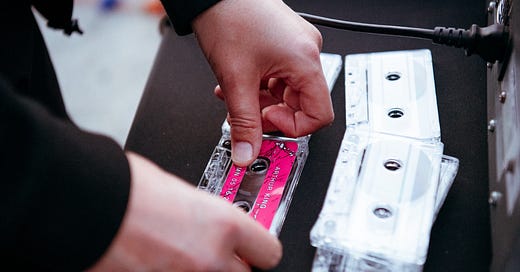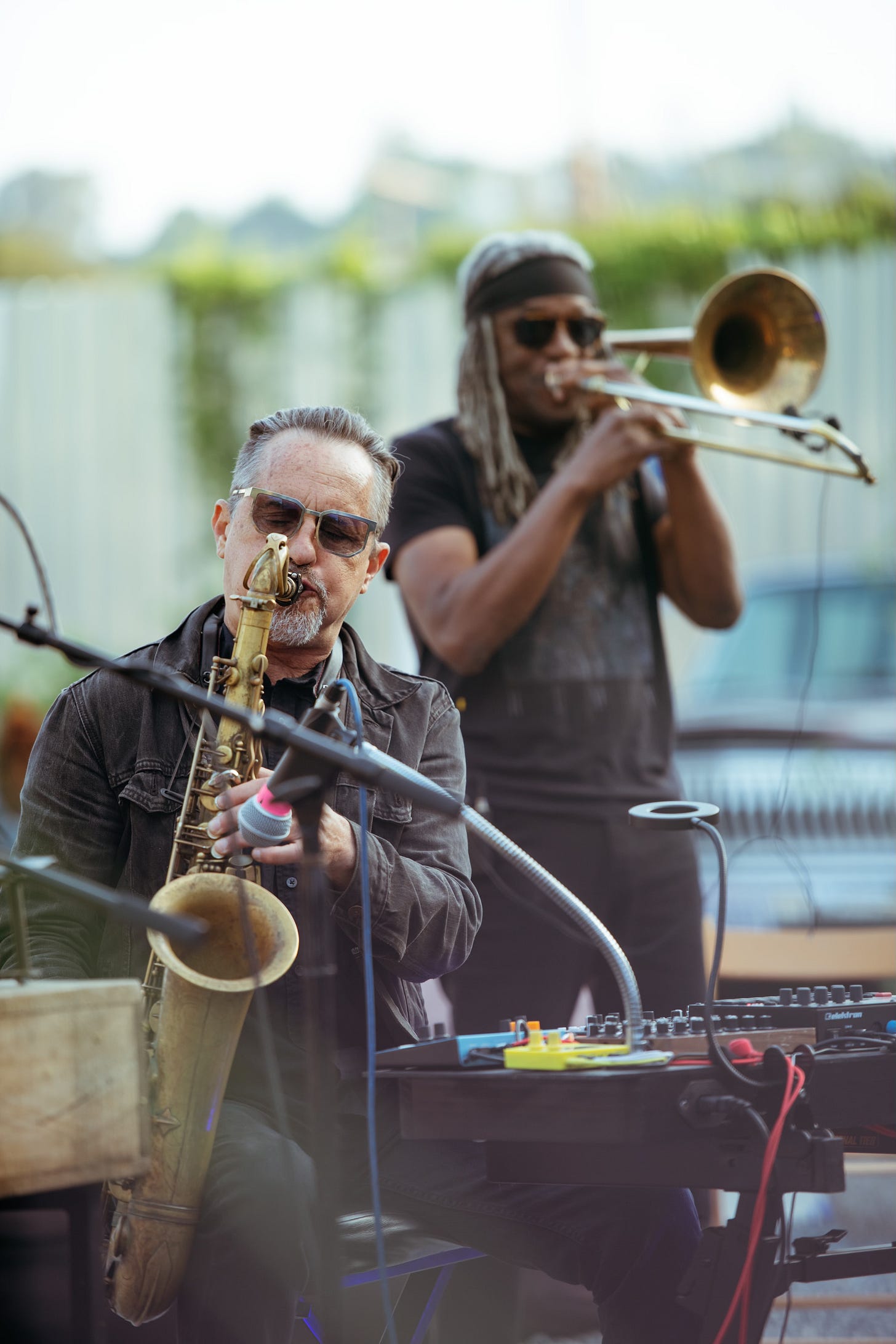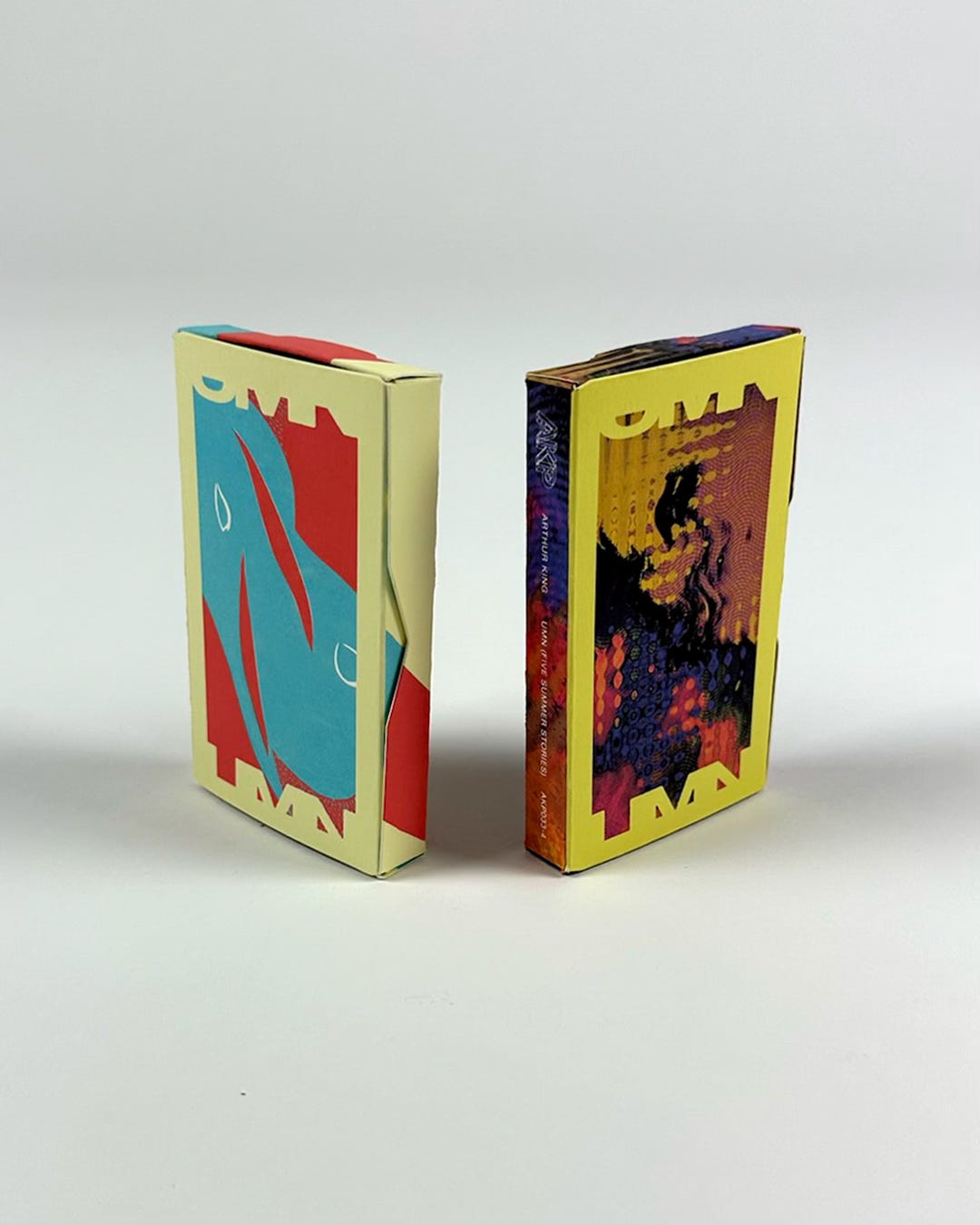Wow & Flutter 011 | Quadraphonic Cassettes
Peter Walker (Arthur King) KamranV (AKP Recordings and dublab) on live experimentation, universal quad accessibility, and letting the process lead the way.
Photo: Zane Roessell
Wow & Flutter: Tell me about the Arthur King ensemble. What instruments are reached for, who comprises the group— is participation fluid, and is it always improvisational?
Peter Walker: Arthur King is more of a framework for sound and visual experimentation than it is a traditionally-understood idea of a musical group. We conceive of and embark on different creative processes, and try to foster and realize the different artifacts that emerge. Even though it’s unimportant to the casual listener, our creative theories and concepts all have roots in depth psychology, which is my field of study and served as a sort of birthplace for the group. There are a few core members who will most likely participate in every AK project, namely me and David Ralicke. The instruments I tend to reach for are guitar, keyboards/synths and/or electronics, which might include drum machines, samplers, drones, tape machines or other noisemakers. Ralicke can effortlessly play most all of the brass and woodwind instruments, and also is very skilled at manipulating electronic instruments… which for him will be defined a bit differently than for me. He gets into sequencers and granular synthesis and such.
Photo: Zane Roessell
The important thing about Arthur King, though, is that every single iteration is different. The processes we adhere to ensure there will be constant variation, whether it be different players joining the group, using new/different gear and/or embarking on new/different methods of creating. We are exclusively a total-improvisational outfit, which, along with these other built-in factors of fluidity provides a unique experience.
W&F: The live album Unknown Movie Night: The Red Turtle is an alternative live score to a critically acclaimed animated film. Had the ensemble viewed the film prior? Take us back to this night and tell us about live recording for quadraphonic sound, and how the space was set up for audience listening in a quad setting.
PW: I don’t think anyone in the band had seen this one. I had heard of the film, being a Studio Ghibli fan, but that’s about it. At their core, the UMN events are really fun experiments, where a film selector chooses a film to basically become the visual conductor for the band. No one knows what film has been chosen until it begins, so the band and the audience are together in discovery and interpretation. The event is not exactly watching a movie, and not exactly watching a band… it’s something in between film and music, I suppose it’s simply experimental art. One thing I love about it is how the recorded artifact stands alone as a piece of long-form music, to be experienced in a different way than it was that evening, without the visual accompaniment. In this sense the whole event is sort of like a bizarre record production technique.
Photo: Christian Kim
KV: It was a magical night. Even before the film was revealed, you could feel the enthusiastic energy from the audience. It was the first time that we had done the event at The River, a beautiful outdoor space right next to the LA River, in Frogtown. As soon as the Studio Ghibli logo appeared on the screen there were delighted screams, seemingly as a release of what everyone was already feeling about the night. The quadraphonic system perfectly steeped everyone into the mood of the composition; people were drawn closer to the mindset of the musicians. The folks in attendance truly became less of an audience and more like emotional collaborators.
W&F: Can you walk us through a brief history of quad from the perspective of live spaces and audience participation? Who in your opinion typically attends a quad show?
KV: I suppose this is the biggest challenge, historically and even today there seem to be very few spaces that are quad/immersive first. The ones that are out there are quite inaccessible (university campuses, The Sphere, etc). It takes a lot of work for us to produce the Unknown Movie Night concerts because we have to build the venue each time. This is also typically how it is for touring immersive artists. Even highly respected artists like Suzanne Ciani who have toured the world in quadraphonic sound over and over again, sometimes have challenges getting venues to handle the basics properly. Hopefully with artists like her and projects like ours, the practice will become more common.
Photo: Zane Roessell
With that said, it is objectively challenging. Most mixing consoles don’t have any easy way to do immersive panning and musicians monitoring the show immersively can be next to impossible. Audiences sometimes aren’t sure what they’re getting into, however for us, putting UMN within the context of a film screening makes it a bit more familiar for folks. In the past, likey the most famous early immersive concerts were of Pink Floyd in 1967. They used mostly only playback in the rears with the live performance mostly coming from the front. There is an excellent video with that history and the equipment that recently came out here.
I must have gotten a dozen text messages from friends asking if I had seen this video when it came out.
A bit later my understanding is that there was a whole scene of people in the Berkeley, CA area, mostly affiliated with the synth maker Don Buchla. His 200 series synth release in 1970 has quadraphonic outputs that can be voltage controlled for movement. Folks like Suzanne Ciani were doing adventurous quad concerts there.
In the 1990s, I grew up and Oklahoma where the Flaming Lips did these incredible parking lot experiments and later boombox experiments where the audience was conducted by Wayne to create the immersive piece.
These experiments ended up being implemented on the Zaireeka record, the four-disc set that you played all four simultaneously on separate systems. Around the same time Mario C and the Beastie Boys did their Quadraphonic Stereo tour. I think Mario told me he had either acquired or recreated the Pink Floyd panners for the system that they used on this tour.
When I was doing Moogfest we did multiple immersive performances, mostly packaged around multi-hour durational performances in quadraphonic sound, ultimately culminating in an entire immersive venue that we created with Meyer Sound at the Durham Armory. I believe it was a 32 channel system.
There are other important experiments out there which folks like Wendy Carlos, Brian Eno and Lou Reed have pushed the way forward.
W&F: Something interesting about this session is releasing a quadraphonic cassette to accompany the work. This seems almost contrary— the limitations of tape coupled with a very dynamic sound environment. What fostered the idea of releasing a cassette, and is the actual physical cassette unique in its properties?
KV: When I was initially figuring out what I wanted to do for Suzanne Ciani’s LIVE Quadraphonic record, before I arrived at the QS Matrix encoded vinyl record, I initially explored getting a bunch of dead stock Tascam 4 track port-a-studios but sadly there weren’t enough that existed by then.
The idea was to make a discrete 4-track tape but it would require a 4-track playback machine. I even researched maybe a way that Moog could help me build a kit to modify existing tape decks to play quad but the cost and level of difficulty were far too high for something like that. With the matrix encoding method (which is the same principle that also allowed VHS tapes to play surround sound), immersive audio can technically exist via any 2-track delivery medium.
Photos: Zane Roessell
Like vinyl, there is a really pleasant, possibly nostalgic feeling that I have holding and listening to a cassette. But unlike vinyl, with cassettes it’s far less complicated to manufacture. We have several Telex tape duplicators that mostly came from churches to do quick duplications at the UMN events. After the show, Peter and I do an Atmos mix of the recording and utilize my QUARK plugin to create the master to copy to tape with high-end Tascam machines. We even invented an all paper, no adhesive case for the tapes so that we could print our own, beautiful plastic-free packages.
W&F: The mastering and production team for The Red Turtle includes the creator of Quadraphonic Universally Accessible Resource Kit (QUARK). Tell us what inspired this tool, and how you’re seeing it utilized out in the world.
KV: Making QUARK came from pure necessity. When I made Suzanne Ciani’s LIVE Quadraphonic I was told that it was the first quadraphonic vinyl in about 30 years. I understand why: it was a multi year research project where I had to find quad enthusiasts in France, Japan, Australia and the US just to even find a way forward. My first conversation was with the legendary mastering engineer Bernie Grundman, who had mastered quadraphonic records in the 1970s. The process was lots of experiments ultimately leading me to use some vintage hardware, some new hardware from an Australian company called Involve Audio and a custom encoder built by an old Akai engineer Odaka Shuichi.
The boxes are AMAZING. However with most things analog, you have a noise floor to contend with. Also, the fact that everything was so custom and rare made it difficult for other people to get in too. If immersive audio is going to be artful and interesting, accessibility is key. I knew that in the coming years that Dolby, DTS and Sony would be pushing new immersive music formats but historically the bar to entry has always been high with this. In the early 2000s, I produced DVD-Audio and SACDs for Interscope Records, so I had seen how difficult it could be and more importantly how ambitious immersive formats can die when accessibility is limited.
After the release of LIVE Quadraphonic, I set out to make a simple plugin version of the “QS” flavor of quadraphonic encoding so it seemed like I could make a free plugin so that anyone could make and listen to quad vinyl, tapes and more through their computer. I got an NEA Grant working with dublab and with my friend Brett Buddin, QUARK was born. We’ve since gotten two other NEA grants related to QUARK with the most recent one allowing us to open source QUARK (QUARK Open) so that others can even build their own apps to encode and decode quad immersive audio for no cost.
The latest plugin build of QUARK was made using QUARK Open and tested on the two forthcoming UMN records.
W&F: Let’s say I want to listen to a quadraphonic work inside my home— what is the ideal and least expensive way to experience this?
Photo: Zane Roessell
KV: As it turns out quadraphonic QS math that we ended up using for QUARK is quite compatible with Dolby’s Pro Logic II, which is in virtually every receiver made since 2001, so most folks simply need to plug an extra pair of speakers in and just push the “surround” button on their immersive receiver, and releases like the QUARK encoded UMN (The Red Turtle) cassette will play back in quadraphonic+ awesomeness.
Of course, accessibility usually means low cost, which is one of the reasons QUARK is free. For those who don’t already have a receiver but do have an Apple laptop, most people’s Macbooks actually have 4 channels of audio outputs built-in: the two speakers in the computer and the headphone output. With a little bit of tweaking, you can use a pair of headphones as your “rear” speakers.
It works surprisingly well and even works with dolby atmos tracks coming from Apple Music, for instance. The Arthur King UMN releases are all available on atmos as well. I just made a quick video on how-to here.
For those wanting to dive a little further, the first part of one of the QUARK instructional videos details some inexpensive equipment that you can still work at a high level. Now that QUARK Open exists, I’m working with a friend on a way to implement QUARK so that you can use as few as two iPhones to create quad. More to come on that.
W&F: The team at AKP mentioned there will be more quadraphonic cassette projects in the future— is it too early to ask what’s next?
Photo: Provided by AKP Recordings
KV: We are working on several, with two of them coming out in October 11th: UMN (March of the Penguins) and UMN (Five Summer Stories). We are in the process of a short film with a quad audio component, a studio EP/gallery installation, and of course more UMNs to come.
QUARK is free. It’s been fun to see others use it out there in the world. Looking forward to both more from us and more from all of the other quad-curious out there.
W&F: What is coming up for the Arthur King ensemble?
PW: Like Kamran mentioned, we have a bunch of projects cooking in the background, all of which have taken on energies of their own as the creative processes unfold. It’s important for me to not have stringent deadlines for projects, I see it as a real privilege to allow both collaborators and projects as a whole the time they might need in order to get perspective on things, allow for artifacts to reveal themselves, and just generally let the process lead the way.
Back to my initial response, the creative process is king here, it’s the reason we’re doing any of this stuff, so must be respected and adhered to at all times. ➿
Go get a tape:
UMN (The Red Turtle) Arthur King
Released March 22, 2024
Recorded live at The River LA
Film Selection by Alejandro Cohen
Produced and Mixed by Peter Walker + KamranV
Recorded by Andy Petr + Jennifer Kraus
Mastered by Phil Feinman + KamranV
Poster design by Sean Conrad
Cover, layout and package design by Francie Chang
Head to Unknown Movie Night this Thursday, September 26:
UMN (Unknown Movie Night) is a recurring series of live film-scoring events where the selected film is unknown to both audience and band until it begins. Discerning film selectors and a rotating cast of guest musicians join Arthur King in making each event unique, taking participants on a journey into the unknown. The next UMN is THIS Thursday, September 26, 2024 at The River , with Film selector: Daniels (Everything Everywhere All at Once, Swiss Army Man) and Musicians: Jessy Greene (Foo Fighters, RZA, P!NK), Adi Meyerson (Little Kruta), David Ralicke (Beck, Dengue Fever, Flight Of The Concords), Adam Topol (Joey Santiago, Ziggy Marley, David Gilmour), and Peter Walker.












This is so pretentious it’s unreadable.